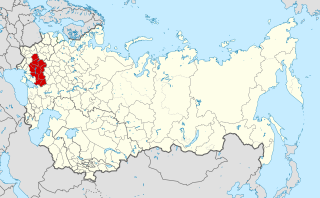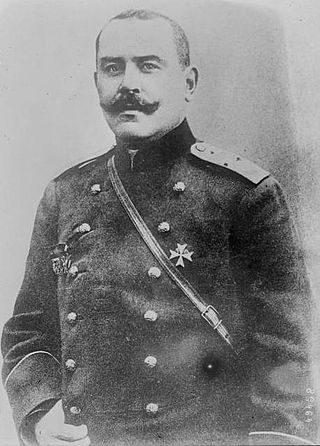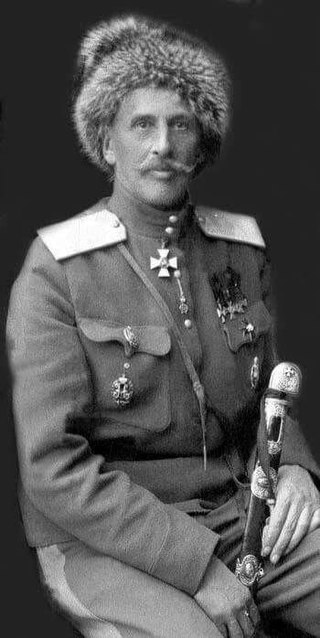
The Russian Civil War was a multi-party civil war in the former Russian Empire sparked by the overthrowing of the liberal-democratic Russian Provisional Government in the October Revolution, as many factions vied to determine Russia's political future. It resulted in the formation of the Russian Socialist Federative Soviet Republic and later the Soviet Union in most of its territory. Its finale marked the end of the Russian Revolution, which was one of the key events of the 20th century.

Anton Ivanovich Denikin was a Russian military leader who served as the acting supreme ruler of the Russian State and the commander-in-chief of the armed forces of South Russia during the Russian Civil War of 1917–1923. Previously, he was a general in the Imperial Russian Army during World War I.

The White movement, also known as the Whites, was one of the main factions of the Russian Civil War of 1917–1922. It was led mainly by the right-leaning and conservative officers of the Russian Empire, while the Bolsheviks who led the October Revolution in Russia, also known as the Reds, and their supporters, were regarded as the main enemies of the Whites. It operated as a loose system of governments and administrations and military formations collectively referred to as the White Army, or the White Guard.

Baron Pyotr Nikolayevich Wrangel, also known by his nickname the Black Baron, was a Russian military officer of Baltic German origin in the Imperial Russian Army. During the final phase of the Russian Civil War, he was commanding general of the anti-Bolshevik White Army in Southern Russia.

Alexey Maksimovich Kaledin was a Don Cossack Cavalry General who commanded the 12th Cavalry Division and Russian Eight Army during World War I. He also led the Don Cossack White movement in the opening stages of the Russian Civil War.

Mikhail Vasilyevich Alekseyev was an Imperial Russian Army general during World War I and the Russian Civil War. Between 1915 and 1917 he served as Tsar Nicholas II's Chief of Staff of the Stavka, and after the February Revolution, was its commander-in-chief under the Russian Provisional Government from March to May 1917. He later played a principal role in founding the Volunteer Army in the Russian Civil War and died in 1918 of heart failure while fighting the Bolsheviks in the Volga region.

Mikhail Gordeevich Drozdovsky was a Russian army general and one of the military leaders of the anti-Bolshevik White movement during the Russian Civil War. In early 1918 he led a regiment of volunteers from the Romanian Front on a march to southern Russia, where they joined the Volunteer Army of the White movement.

Sergey Leonidovich Markov, was an Imperial Russian Army general, and became one of the founders of the Volunteer Army counterrevolutionary force of the White movement in southern Russia during the Russian Civil War which broke out in 1917.

Vladimir Zenonovich May-Mayevsky KCMG was a general in the Imperial Russian Army and one of the leaders of the counterrevolutionary White movement during the Russian Civil War.

The Southern Front was a military theater of the Russian Civil War.

The Don Army was the military of the short lived Don Republic and a part of the White movement in the Russian Civil War. It operated from 1918 to 1920, in the Don region and centered in the town of Novocherkassk.

The Kiev Military District was a military district of the Imperial Russian Army and subsequently of the Red Army and Soviet Armed Forces. It was first formed in 1862, and was headquartered in Kiev (Kyiv) for most of its existence.

Vladimir Mikhailovich Dragomirov was a general in the Imperial Russian Army.

The Armed Forces of South Russia (AFSR or SRAF) (Russian: Вооружённые силы Юга России, romanized: Vooruzhyonniye sily Yuga Rossii, VSYuR) were the unified military forces of the White movement in southern Russia between 1919 and 1920.

The Battle of Tsaritsyn was a military confrontation between the Red Army and the White Army during the Russian Civil War for control of Tsaritsyn, a significant city and port on the Volga River in southwestern Russia.
Vladimir Ivanovich Selivachyov was a lieutenant general of the Imperial Russian Army during World War I who became a commander of the Red Army in the Russian Civil War.

Vladimir Ilyich Sidorin was an officer in the Imperial Russian Army and Commander of the Don Army between February 1919 and April 1920 during the Russian Civil War.

The Advance on Moscow was a military campaign of the White Armed Forces of South Russia (AFSR), launched against the RSFSR in July 1919 during the Russian Civil War. The goal of the campaign was the capture of Moscow, which, according to the chief of the White Army Anton Denikin, would play a decisive role in the outcome of the Civil War and bring the Whites closer to the final victory. After initial successes, in which the city of Oryol at only 360 kilometres (220 mi) from Moscow was taken, Denikin's overextended Army was decisively defeated in a series of battles in October and November 1919.

The Stavka of the Supreme Commander was the supreme headquarters of the Russian Imperial Army in the field during World War I until the demobilization of the army in March 1918.

Count Fyodor Arturovich Keller was a Russian General of the cavalry, one of the leaders of the White movement in 1918, and monarchist.



















